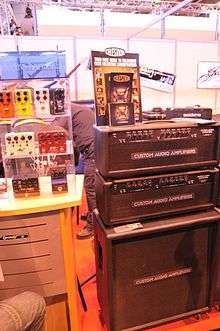Celestion
| Public | |
| Industry | Audio |
| Founded | 1924 |
| Headquarters | Ipswich, England, United Kingdom |
Area served | Worldwide |
| Products | loudspeakers |
Number of employees | approx. 1,400 |
| Parent | Gold Peak Industries |
| Website | Company website |
Celestion is a British maker of loudspeakers.
History


The work of what would become Celestion started in Hampton Wick (suburban London) in 1924. Celestion Radio Company and Celestion Limited were formed in 1927, and two years later the company moved across the Thames to Kingston. The company grew rapidly, but was hit by the depression. Wartime restrictions forced Celestion and the nearby British Rola Company to produce loudspeakers to the same specification; British Rola bought Celestion in 1947 and moved production to Thames Ditton a year later. The name of the company changed to Rola Celestion; with its products sold under the brand name "Celestion". (MPP, later a camera maker, was formed as a subsidiary during the war.)
Production of radio, television and "hi fi" speakers continued in the postwar years. Rola Celestion was bought by Truvox - a manufacturer of public address systems in 1949.
In 1968 the company started production in Ipswich, moving all production there by 1975. The company merged with a clothing company in 1970 and the result was named Celestion Industries, which in turn became Celestion International in 1979.
In 1992 the loudspeaker part of the business was sold to Kinergetics Holdings, which also bought KEF.
Today Celestion International and KEF form GP Acoustics UK. In 2006 Celestion ceased to manufacture pro audio finished systems and now completely focus on the manufacture of guitar, bass guitar and pro audio drivers.
Products
In 1982, Celestion broke new ground in loudspeaker technology when they presented the SL6, a compact hi-fi speaker featuring the first ever metal dome tweeter, made of copper and designed with the help of laser interferometry. They followed this model up with the SL600, which used rigid honeycomb alloy called Aerolam instead of wood in the speaker casing; a material previously used only in the aerospace industry. Both these speaker models, while highly regarded as "breakthrough" designs with outstanding high-frequency clarity, also known for a somewhat "depressed" sounding high-frequency range, as a result of the relatively heavy copper dome tweeter. Later iterations of this design deployed a similar tweeter, but with the dome made out of aluminum, a much lighter and more efficient driver, which allowed for a more balanced output with the woofer. The aluminium-domed versions, in the standard cabinet (MDF and wood veneer) were designated as the SL6s, and then (with an improved crossover and woofer surround) the SL6si; The aluminium-domed models using the Aerolam cabinet (the honeycomb alloy) were designated as the SL700 and the (improved) SL700SE which dual inputs—i.e., separate inputs for woofer and tweeter (allowing for bi-amping or bi-wiring). Around that same era, another version of the copper-domed model, with both the Aerolam cabinet and improved crossover elements, was marketed as the SL600si, also with dual inputs. Finally, in 1992, Celestion produced the final variation of this design, as the Ten Year "Anniversary Edition" Model 100, which featured a conventional, but highly refined MDF / wood veneer cabinet, dual inputs, updated mounted plates, an improved crossover, the improved woofer design, and a variation of the aluminium tweeter with an updated faceplate.
The Celestion Blue can claim place as the world’s first dedicated guitar loudspeaker. The 1950s witnessed the emergence of the electric guitarist and Celestion responded to their needs for a rugged, reliable loudspeaker by modifying a standard "G12" radio speaker. The unique tonal character of what came to be known as the Celestion Blue, combined with the valve amps of the time, helped to define the electric guitar as we know it today. It was rapidly adopted by pioneers of rock & roll and popular music throughout the late 50s and early 60s. Other popular Celestion guitar loudspeakers include the Vintage 30 and the Greenback.
Celestion speakers are used by a variety of different amp companies including Orange Music Electronic Company, Vox and Marshall Amps.[1][2]
References
- ↑ "Rig Rundown: Against Me!". Premier Guitar. Retrieved 20 April 2015.
- ↑ "MESSE 2015: New Range Of Marshall Amps". Sonic State. Retrieved 20 April 2015.